
Bulletin 9-10 (V:1-2), 1967
Home
Français
Introduction
History
Annual Index
Author &
Subject
Credits
Contact

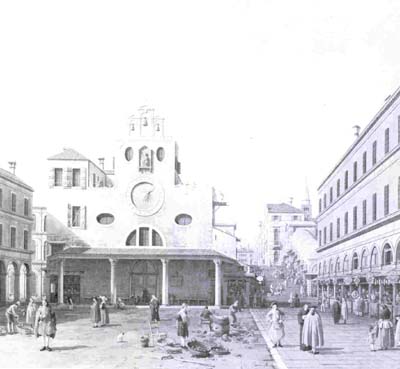
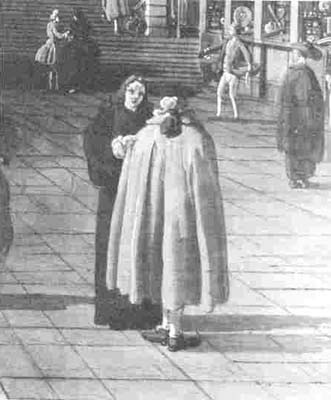
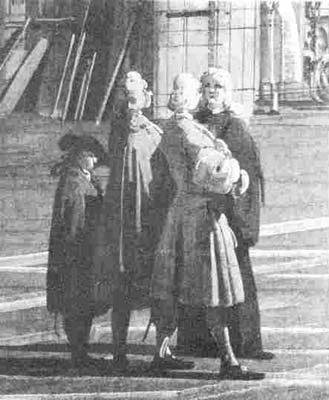
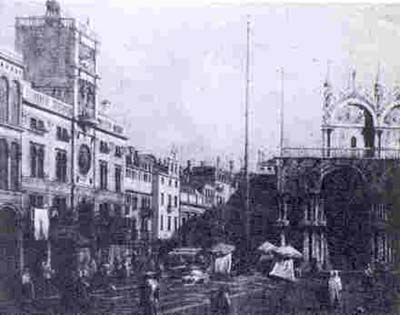
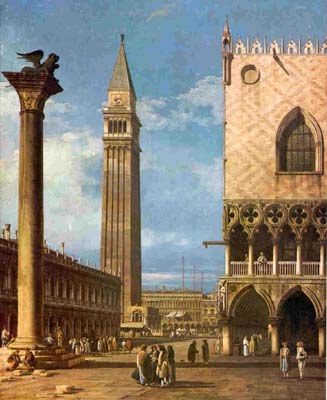
Bernardo
Bellotto's Venetian Period (1738-1743)
by Professor Terisio
Pignatti, Vice-Directore
Musei Civici Veneziani
Pages 1 | 2 |
3 | 4
A distinction can be made, however, between the styles of the two
artists. Bellotto's sharply-defined shaded areas are quite different
from Canaletto's more tonal gradations with shadow. His bold,
incisive strokes are always darker in tone than Canaletto's. And he
used parallel strokes to portray the reflections in the water and
the shadows in the sky. On the basis of style of these drawings, it
is possible to make the hypothesis that Bellotto was less
artistically endowed, less imaginative, more concerned with the
exact representation of light, and more impressed with the
importance of the accurate graphic representation of architecture,
as if his drawing were in preparation for an etching.
Would there be similar differences between paintings attributed to
Bellotto and others attributed to Canaletto? The paintings that
should be considered are from the end of Bellotto's Venetian period,
such as those of Vaprio, Varese or Turin of 1745, or the Venetian
scenes that he painted from memory on his first trip to Dresden in
1748. The
Porte del Dolo (plate 4), from Dresden, was signed by
Bellotto and dated 1748, and had obviously derived from the print
that Canaletto had made of the same subject. Bellotto modified it in
a way that was very characteristic of his style at the end of his
early period. The perspective is widened, producing a theatrical
effect; the palace at the back was completely imaginary; ruins were
added on the right - evidence of Roman influence. The rendering of
light and shadow is very original; the light is radiant and the
shadow spreads across the foreground of the painting. Phantom-like
figures, reduced to simple outlines, emerge from the shadow and
appear against the light. Here and there, the veil of shadow is
drawn to reveal small figures illuminated by the incisive rays of
cold light as if they were on stage.
The result of these devices is an essential lack of unity. The
colour suffers, often strained to give the effects of light, often
applied with heavy paint to stand out in the shadows but
nevertheless singulary monotonous. This picture seems, in short,
like the work of a beginner who, although talented, has by now; left
the road he travelled at the beginning - Canaletto's - and is
finding his own way of interpreting reality, penetratingly,
aggressively, and with light.
Canaletto used light and colour in a different way. If we examine a
painting characteristic of these years, such as
The Vegetable Market
and San Giacometto di Rialto in the National Gallery of Canada
(plate 5), we are facing a harmonious masterpiece with restful
colours and a relaxed atmosphere. Lights and shadows are delicately
blended and the dust-like colour makes the transition infinitely
softer in the figures and in the architecture. Canaletto's
"reality" was a harmonious environment, somewhat
abstracted so that it possesses a light rarified beyond true
physical reality.
Bellotto's technique in his early period was very different from
Canaletto's. He would start with his uncle's sketch but then sharply
outline each detail more incisively. The light became artificial
with a cold, almost twilight, bluish tone. He would use strokes of
nearly pure hue to strengthen the outlines and the sculptural forms.
The human figures consequently look quite solid; they were
"constructed" with thick brush strokes of heavy paint not
blended as they are in Canaletto's paintings of the same period: the
Feast Day of San Rocco in London,
The Vegetable Market and San
Giacometto di Rialto (plate 6)
and
Piazza San Marco (plates 7 and 8)
from the National Gallery of Canada, and the
View of the Zecca in
the Carandini Albertini collection (plate 12).
By using this technique, Bellotto reduced the human figures to
characteristic forms which are far removed from those of Canaletto's.
The features of the faces become simple blots - the eyes and mouths,
black, and the noses and wigs, white; these faces can be seen in the
View of the Po of 1745 (plate 9) from the Pinacoteca Sabauda in Turin
and in the Porte del Dolo from 1748 in Dresden (plate 10). Another
characteristic of Bellotto's during this period was the way he
depicted buildings. In the
Porte del Dolo, the buildings have
well-defined outlines, made by parallel brush strokes of colour
juxtaposed against the changing rays of light. In the shadows, where
light was needed to create volume, a very fine line of cadmium
yellow was placed along the edge of arches (plate 11) or between the
lighted surface of the cornice and its shadow - a technique that has
never been found in Canaletto's work (plate 12). The shading in
Bellotto's work has an almost ink-blot type of heaviness, arising
from the cold, rather static way in which he rendered light and
shade. There is also a chromatic contrast that cannot be seen in
Canaletto's work.
These distinctions between Bellotto's early work and Canaletto's
could be applied to paintings that have been attributed to Canaletto.
If Guarienti's statement that "Bellotto painted in a way that
was so similar to Canaletto's that it was difficult to distinguish
between the two" be accepted as true, it would not be
surprising that such early Bellotto works could be mistaken for
Canaletto's. In the Canaletto exhibition in Canada, there were four
paintings -
The Piazetta Looking South (plate 13)
and the Entrance
to the Grand Canal (plate 14)
from the collection of J.
M.
Mills,
and
the Piazetta Looking North (plate 15) and
The Arsenal (plate 16)
from the National Gallery of Canada (11) - that did seem to fit in
with other paintings by Canaletto such as the
Feast Day of San
Rocco from the National Gallery in London, or
The Vegetable Market
and
San Giacometto di Rialto (plate 5) and
Piazza San Marco (plate
8) from the National Gallery of Canada.
These paintings obviously belonged to a single series. They not only
had the same tonality - the blue silver characteristic of Bellotto -
but also the same size (59" x 48", varying, if at all, by
no more than 1/2."). In addition, the Venetian subjects are so
complementary that it seems they must have been painted
simultaneously for a formal setting - a palace or a hall. Little is
known about the history of these works before the nineteenth
century; (12)
they have, however, always been attributed to Canaletto
because of their remarkable quality: they are clear, bright and,
particularly in the dotting of the small figures here and there,
extraordinarily vivacious.
The fact that it has been difficult to fit them into Canaletto's
oeuvre could be noticed in the arrangement of these paintings in the
Montreal showing of the Canadian exhibition. The two Mills canvases
were placed near the
Piazza San Marco (plate 8) from the National
Gallery of Canada, which the eminent authority, W. G. Constable,
dates prior to 1735, (13)
whereas in their contrast of light and
shadow they would have been more at home with Canaletto's work from
1730, with, for example, the authentic Windsor canvases. (14)
On the
other hand the two canvases from the National Gallery of Canada were
placed close to the Gallery's
Vegetable Market
and
San Giacometto di
Rialto
(plate 5), which is dated between 1740 and 1746, perhaps
because they are somewhat clearer and more luminous.
Next Page | Four
paintings
1 |
2 | 3 |
4
Annual Index | Author & Subject | Credits | Contact
This digital collection
was produced under contract to Canada's Digital Collections program,
Industry Canada.
"Digital
Collections Program, Copyright
© National Gallery of
Canada 2001"